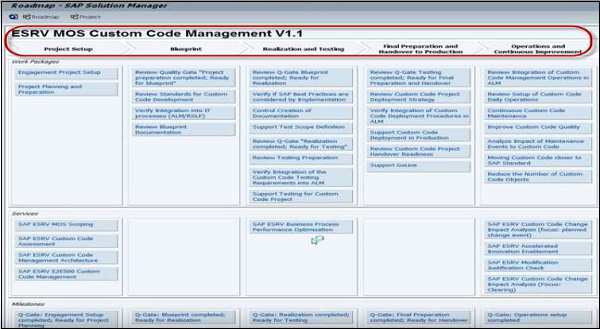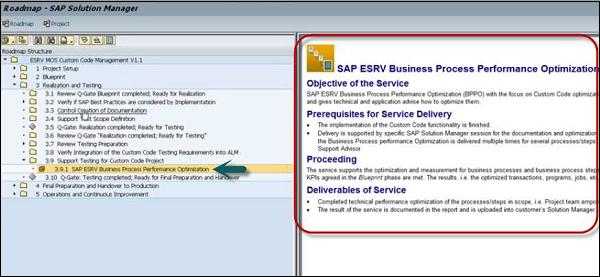
- SAP Solman Tutorial
- SAP Solman - Home
- SAP Solman - Overview
- SAP Solman - Features
- SAP Solman - Work Center
- SAP Solman - Work Center Structure
- SAP Solman - Implementation
- SAP Solman - Infrastructure
- SAP Solman - Operations
- System Landscape Information
- Guided Procedure Authoring
- SAP Solman - Template Mngmt
- SAP Solman - Test Management
- SAP Solman - IT Task Management
- Change Control Management
- SAP Solman - Incident Management
- SAP Solman - Service Desk
- Business Process Operations
- Application Operations
- Maintenance Management
- SAP Solman - Upgrade Project
- SAP Solman - Root Cause Analysis
- SAP Solman - Reporting
- Consultant Responsibilities
- SAP Solman Useful Resources
- SAP Solman - Questions Answers
- SAP Solman - Quick Guide
- SAP Solman - Useful Resources
- SAP Solman - Discussion
SAP Solman - Implementation
SAP Solution Manager provides you with central access to all the tools, documents, functions, and methods that are required for a project implementation. It supports all the key project phases that you need to configure for business scenarios as a part of solution implementation.
As a part of solution implementation, you need to define the following Project phases −
Defining a Project
First step in solution implementation is to define a project.
Step 1 − Go to Project Administration Work Center. Create a project by defining a system landscape for phases involved in project and scope of the project. As per the scope of the project, structure hierarchy is defined for business processes and scenarios.
In SAP Solman, all the administrative tasks are performed under Project Administration work center.
Run the Transaction Code − SOLAR_PROJECT_ADMIN to open Work Center. Transaction code is a predefined set of functions.

Step 2 − To create new project, go to Project → Create.

Step 3 − Next, enter a project ID and title. The ID must have a combination of letters and numbers up to 10 characters and click continue.

Step 4 − Enter the information under the following tabs while defining a Project. Each tab has multiple fields and a few are optional. The middle column shows the navigation for each tab and the options under it.
| Functions | Navigation/Tab Name | Optional/Required |
|---|---|---|
| Create projects | Project → Create | |
| Specify general project begin and end data | General Data tab | Optional |
| Project language | Required The project language cannot be changed later | |
| Project scope. Copy templates into the project | Scope tab | Optional |
| Assign team members to project | Project Team Members tab | Optiona |
| Definition of project standards (status, documentation types, keywords) | Project Standards tab | Optional |
| Definition of project system landscape | System Landscape tab | Required for subsequent navigation in managed systems |
| Distribution of IMG projects in the managed systems | System Landscape tab IMG Projects subtab | Required for configuration and customizing distribution |
| Create transport requests in the managed systems | ||
| Project transport details | Transport Requests tab | Only in template projects Required for template projects whose templates are to be reused in other system |
| Create, release, transport templates | Templates tab | Only in template projects |
| Download/Upload for Business Blueprint Projects | In a project, choose Edit → Fill Business Blueprint | Optional |
| Manual deletion of persistent locks which the system does not delete automatically | Tools → Delete Persistent Locks | Optional, if you need to unlock objects manually. For more information, see the application help. |
A new screen appears to create a project.
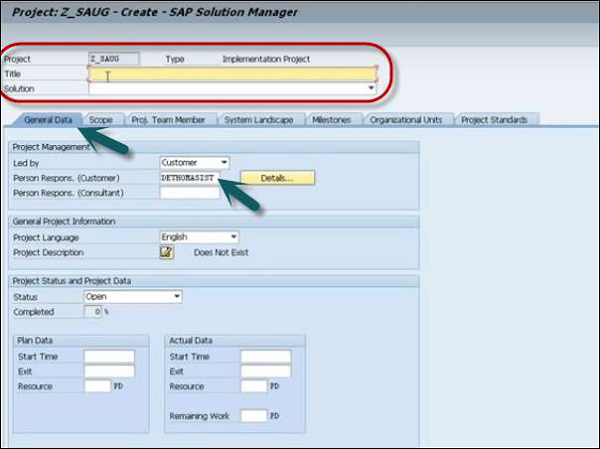
Step 5 − Select the Project type from the drop-down list.

Various project type options are available in SAP Solman.
Implementation project
This is required when you need a project to implement business processes in a SAP landscape.
You can select an existing structure based on business processes or you can also create a new project structure as per the following points −
- One or more user or partner templates
- Based on an existing project
- An existing solution landscape
Template project
Template project is used to create a template that defines the project structure or some part of your project. Templates can also be used in other projects by transporting the template. It is also possible to lock templates against any changes made- either completely or partially when they are used in other projects.
Optimization project
Optimization project type is used to optimize business processes.
Upgrade project
Upgrade project is used to upgrade an existing system. You can upgrade an existing function or add additional functions.
Maintenance Project
Maintenance project type is used to maintain an existing project. This can include Maintenance activities, or correct any existing solution.
Step 6 − Once you select the Project type, enter the following General data −
- Person Responsible
- Project Status
- Led By and other relevant details.
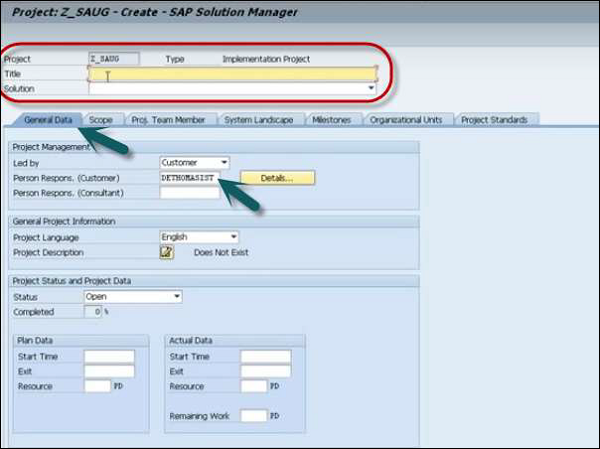
Step 7 − Next define the project scope. Go to the Scope tab and select the Roadmap.
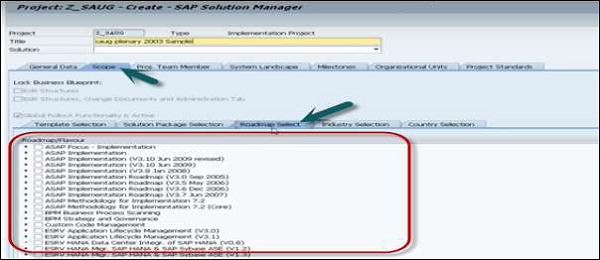
Step 8 − Once you select all relevant options- like Code Management, Business Process Scanning, Focus Implementation, click the save button at the top.
Step 9 − Select Enhancement and Release. Click the green tick mark.

Step 10 − Next is to define project Blue print. Click the Go to button at the top, Project → Business Blueprint.

To define Business blue print, you have to select the source system.
Click the drop-down list. You will see the following options −
Business Process Repository − To define blue Print in business process repository.
Solution − You can define a business blueprint in Solution as package. (Solution in Solution Manager is explained in a separate topic).
Project − You can define the business blueprint as a Project.
Step 11 − Select Business Process Repository from the drop-down list.

Step 12 − Define the Scenario name as per the project scope defined. Go to SAP Solution Manager → Custom Code Management → SAP Solution Manager 7.1
Click the green tick-mark icon.
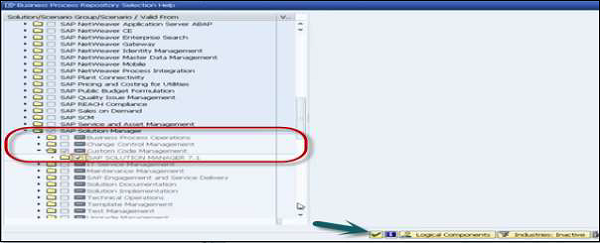
Step 13 − Next step is to assign Logical components.
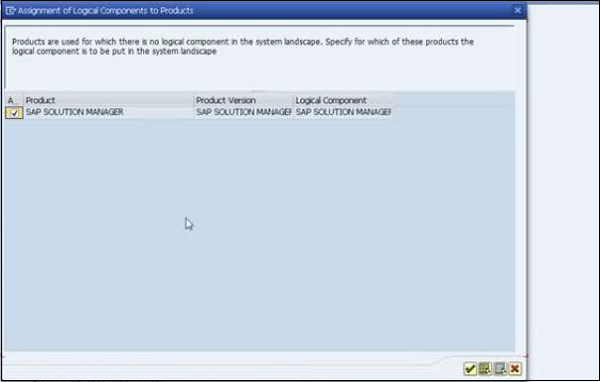
Step 14 − Expand the hierarchy in the left pane as Business scenarios → Custom code management → Business Processes → Custom Code Transparency.
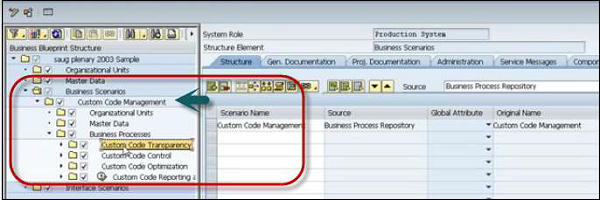
Step 15 − To view the documentation under this project, click the General Documentation tab. You can see all the document types that have been created for this project.

Step 16 − In a similar way, to see full hierarchy and associated document, you can expand any project in the left pane and select any component.
As shown in the following snapshot - Display Results: Reporting/Analysis is selected to see logical component and object name.
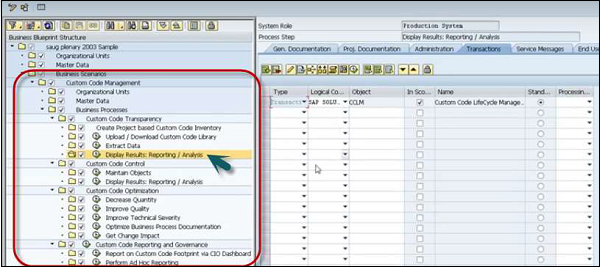
Step 17 − Go to Get Change Impact and you will see logical component and object name for the same.
To see the roadmap, go to Environment → Roadmap

The screenshot given below shows all the phases in Project Roadmap. You can check the details for each object- objective of service, perquisites, deliverables, etc.
